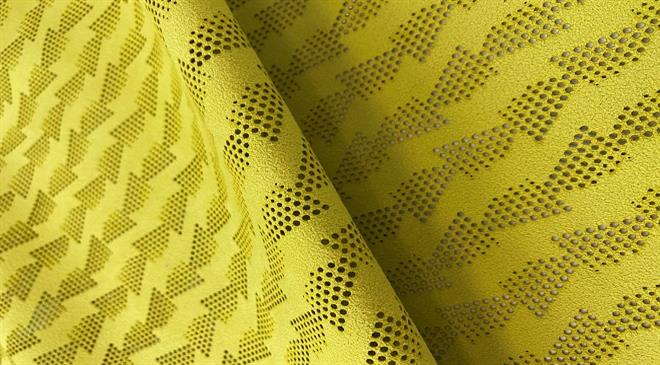We'll be Climate Positive by 2030
Miko Srl, a subsidiary of US-based Sage Automotive Interiors and a member of Japan's Asahi Kasei Group, is an Italian company that produces Dinamica, claimed to be the first ecological microfibre with unique characteristics suitable for a variety of applications. In a discussion with Paulami Chatterjee, Benedetta Terraneo, marketing and design manager at Miko, speaks about the new enhanced Dinamica Auto Pure range of fibres, which promises even less carbon dioxide emissions, and the various certifications Miko is aiming to achieve by 2030.
Give us a general background of Miko. How and when was it formed? Who are the key people involved? How big is the team of Miko?
Miko Srl was established in 1997 and immediately set its headquarters in Gorizia. Since the beginning of its activity, the company has been focusing on producing an innovative non-woven microfibre called Dinamica, adaptable to multiple sectors of application, especially for automotive interiors.
The lifecycle of Dinamica starts in Japan in Asahi Kasei that manufactures and delivers the raw non-woven fabric to Italian company Miko, where the material is dyed, finished and sold worldwide.
Miko employs 93 workers divided among the administration and commercial departments (in the area dedicated to offices), production department (dyeing, finishing, quality control, recipe preparation, laboratory, service) and logistics (shipping and warehouse).
In line with the dynamic spirit of the group, in 2018, Sage Automotive group was acquired by Asahi Kasei, to follow the entire supply chain closely and better the Dinamica brand. Therefore, Miko Srl is currently fully controlled by Asahi Kasei Corporation.
Dinamica has got many certifications like EPD, PETA approved Vegan etc. Are there any new certification you are working towards achieving with Dinamica?
We are fully committed to reach the Sustainable Development Goals (SDGs) by 2030. Of the 17 objectives of the 2030 agenda, the company is already committed to 13 of them, with numerous targets involved, especially those related to the social and environmental sphere, such as climate change.
With this in mind, the long-term target is to become climate positive by 2030 (including the compensation of the organisation and the complete life cycled of the products) through a series of actions with FSC for the protection of forests located in Europe, North America and Asia.
In addition, we are working to reach the Global Recycle Standard (GRS) certification for all our products by 2025. Having a high amount of recycled content, this certification is a further guarantee of the circular economy of Dinamica products.
Which are your major markets geographically?
In the current picture, it is Europe, then North America and China. However, the Chinese market is growing quickly and potentially. In the future, it could become the second largest market for Dinamica.
What is the USP of Dinamica fibre?
Dinamica's production process avoids the extraction of virgin raw materials as it is based on the recycling of waste that would otherwise be discharged in landfills or incinerations. The recycled polyester contained in Dinamica derives from polyester fibre (T-shirts, fabrics, fibres) and PET (bottles, plastic, etc). Recycling polyester means reducing energy consumption and carbon dioxide emissions into the atmosphere by 80 per cent compared to the traditional petrol-based polyester production process.

Where is Dinamica fibre sourced from?
The recycled fibres of Dinamica come from Japan. Through an innovative process called Eco-Cycle, the polyester waste is collected and transformed into polyester fibres by Japanese company Teijin.
What are the various solutions Miko has created for the automotive market with recyclable microfibres that are environment friendly and comply with the highest standards?
Dinamica is designed for easy disposal and is 100 per cent recyclable. Miko has introduced Dinamica Auto Pure to the market-a new member of the company's family of automotive interior materials, in which even the inner scrim comes from recycled fibres. Two hundred and forty two grams of recycled PET fibre is used to produce 1 square metre of Dinamica Auto Pure, corresponding to approximately 73 per cent of the total product weight. Going from 45 per cent to 73 per cent recycled content of the total weight, Auto Pure features 3.1 per cent less carbon dioxide emissions in the production process compared to the standard Dinamica Auto, equal to 181 g of carbon dioxide less for square metre according to its certified life-cycle analysis.

How much of forest area in Bosco Sacile has got covered under your sustainability programme? How much of carbon footprint will it help in reducing?
This project is focused on the complete restoration and conservation of Bosco Sacile (Udine area, Italy), through reforestation and forest improvement interventions that guarantee the capture and conservation within five years of 5,600 TCO2/year, that is 100 per cent of the annual environmental impact of Miko Srl.
Currently we are taking care of more than 5,000 trees in this area. The forest obtained the FSC certification last July: a tool designed by the Forest Stewardship Council (an international non-profit organisation) to ensure responsible management of forests around the world.
What is the raw base that Asahi Kasei provides for production of Dinamica?
Asahi Kasei uses the recycled fibres in their water-based process to produce the three-layer structure of Dinamica base.
In fact, under the microscope, the material is composed of three layers: face, inner scrim and backing. Submerged in a water solution, the inner scrim attracts small polyester fibre, which is suspended in the liquid, to both surfaces; these are compacted using a water-based needle punching process. The microfibre is then immersed in a water polyurethane bath, which, in contrast to normal production cycles, does not contain the solvents that are harmful to health and the environment. This process makes the fibres compact, making them elastic and resistant.
What is the average time taken right from sourcing the raw material to the finished Dinamica fibre?
The production lead time for the greige production in Asahi Kasei/Japan is 12 weeks. The production lead time for the Dinamica production in Miko/Italy is six weeks.
Which are the various other regions or forests where you want to replicate this model?
In 2021, we will start introducing new forest projects in Germany (near Stuttgart and Wolfsburg) in areas that we selected because close to the headquarters of two important customers. Next, we will start action in North America and Vietnam. By 2030, we are targeting to compensate 190,000 tonnes of carbon dioxide.
What are the latest breakthrough technologies your team is working on?
We are working to push the circular economy of Dinamica from cradle to cradle. Together with a company located in the Czech Republic, we are studying how Dinamica can be recycled at the end of its useful life and transformed into something else and valuable that can be reused in the automotive industry or in other sectors. We consider this investigation part of our company responsibility because offering to our customers valuable options of reusage is in line with our business model.
Where are your factories based at? What is the annual production capacity at them?
Asahi Kasei manufactures and delivers the raw non-woven fabric to Miko, where the material is dyed, finished and sold under the brand name Dinamica.
In 2019, Miko sold 3.2 million linear metres of Dinamica for a total turnover of €109 million.

What are the various application areas/sectors for Dinamica?
Mainly used as automotive interior surface material, it is used in covering seats and headrests, headliners, door panels or steering wheels of renowned car models like the Porsche Taycan, the Mercedes-Benz AVTR concept car, the Volkswagen ID.3 or the Q5 by Audi. The premium look and feel is one distinctive feature of the material. The other one is its sustainability.
Other brands that feature Dinamica are JLR, BMW, GM, Ford, FCA, Volvo, Seat, Skoda, Hyundai and KIA.
What are your future plans? Are there any major announcements in pipeline?
We are expecting further growth in sales in the next couple of years due to important new projects with the VW Group. Asahi Kasei has planned to build a fourth production line for the greige of Dinamica to be completed by 2022 with a total investment of $50 million. (PC)

What percentage of sustainability and circularity does Dinamica promise?
The current product line has up to 45 per cent of recycled content and it is solvent-free. During dyeing, the use of neutral, non-toxic colouring agents is a further guarantee of the product's naturalness. However, the promise of Miko is to improve the circular economy of all products in the next five years and increase the amount of secondary raw material in the life cycle of its products.





